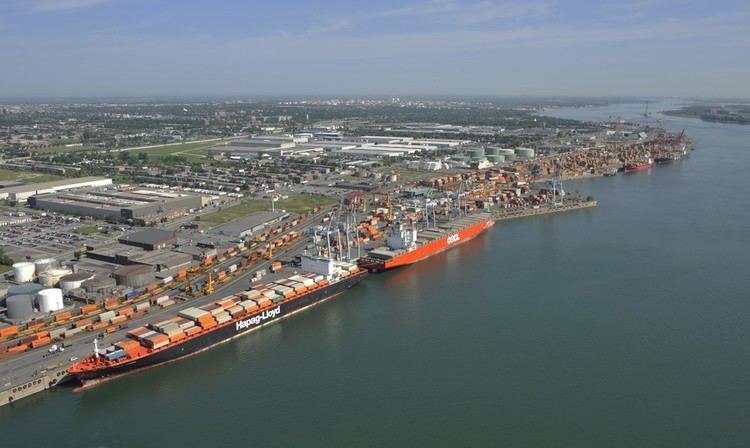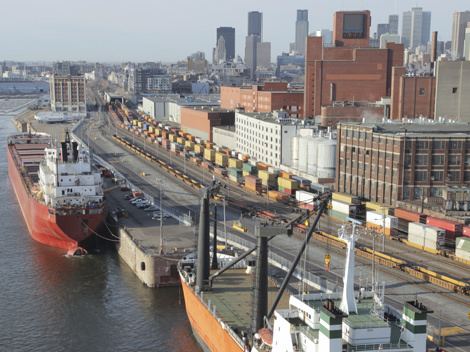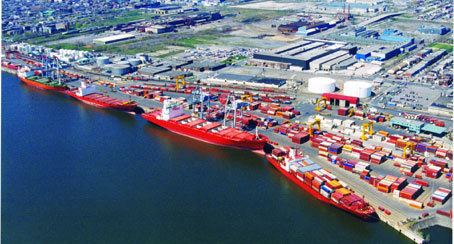Country Canada Area 6.354 km² Annual revenue 85.6 million CAD (2012) | Owner Government of Canada Net income 9.1 million CAD (2012) | |
 | ||
Location Montreal, QuebecContrecœur, Quebec Opened Montreal Port Authority 1999Montreal Port Corporation 1983National Harbours Board 1936Harbour Commission 1830 Operated by Montreal Port Authority Land area 6.35 km (2.45 sq mi) (Montreal)4.67 km (1.80 sq mi) (Contrecœur) | ||
Port of montreal
The Port of Montreal (French: Port de Montréal) is a port and transshipment point on the St. Lawrence River in Montreal, Quebec, Canada. On the Saint Lawrence Seaway 1,600 kilometres inland from the Atlantic Ocean, it is on the shortest direct route from Europe and the Mediterranean to North America. It is an international container port that services Toronto and the rest of Central Canada, the U.S. Midwest, and the U.S. Northeast.
Contents
- Port of montreal
- Gone trucking port of montreal a to z
- Timeline
- Management
- Port territory
- Container
- Grain
- Dry bulk other than grain
- Liquid bulk
- Cruise
- Markets
- Economy
- Environment
- Awards
- References

In 2012 More than 2,000 cargo ships visited, with the port handling 28,422,003 tonnes (31,329,895 short tons; 27,973,121 long tons) of consumer goods, machinery, cereal, sugar, petroleum, products and other types of cargo. Montreal also welcomes cruise ships. It is operated by the Montreal Port Authority.

The port originated in the historic area now known as the Old Port of Montreal. Over the years, the Port of Montreal expanded eastward along the waterfront. In 1978, the Port of Montreal ceded the area now known as the Old Port to the Old Port Corporation, a public corporation responsible for developing tourism and recreational activities in the area. The site is now a cultural gem and a major tourist attraction, having been enhanced with museums, restaurants, shops and water-related activities. Today, most Port of Montreal facilities are located downstream from the Old Port. The Montreal Port Authority's head office and the multipurpose Bickerdike Terminal are located upstream from the Old Port.

Gone trucking port of montreal a to z
Timeline
Starting from the first authority:

Management

The Montreal Port Authority operates the Port of Montreal. The port authority is an autonomous self-financing federal agency created under the terms of the Canada Marine Act. The port authority provides facilities to shipping lines and land carriers, to terminal operators and to freight transport. It builds and maintains infrastructures that it leases to private stevedoring companies.

The port authority directly operates a cruise passenger terminal and its own railway network, which includes more than 100 kilometres (60 miles) of track and provides transcontinental railways with direct access to almost every berth.
The port authority's board of directors is composed of seven business people from the Montreal area. Each of three levels of government – federal, provincial and municipal – names a director. The federal transport minister, on the recommendation of port users, names the remaining four directors. The board is elects its own chairman.
As of 2012 the Port Authority had 237 employees, total revenue from operations was $85.6 million and its net earnings totalled $9.1 million.
Port territory
On the island of Montreal, port territory stretches along 26 kilometres of waterfront from the Victoria Bridge at the upstream end of the port to Pointe-aux-Trembles at the downstream end of the port.
The port also has a terminal at Contrecoeur, on the south shore of the St. Lawrence River about 40 kilometres downstream from Montreal. The port owns land along four kilometres of waterfront at Contrecoeur. This land will be used to increase the port's container-handling capacity once its land on the island of Montreal reaches full capacity.
Container
Container ships are completely unloaded and loaded. Container shipping lines calling the port include CMA CGM, Hapag-Lloyd, Maersk Line, Mediterranean Shipping Company and OOCL.
The port has three international container terminals. Montreal Gateway Terminals Partnership operates two of the terminals and Termont Montreal Inc. operates the other. Empire Stevedoring Co. Ltd. operates a terminal that handles domestic containers. These facilities cover an area of approximately 90 hectares (36 acres) and have 15 dockside gantry cranes with lifting capacities ranging from 40 to 65 tonnes, yard gantry cranes and other container-handling equipment.
Grain
The port signed an agreement in 2011 with Viterra Inc., to lease and operate the port's grain terminal. Total grain traffic through the port increased by 76.3% to 3,070,054 tonnes in 2012, the first full year of operation of the grain terminal under Viterra. The grain terminal is a combined loading and unloading facility that has a total storage capacity of 260,000 tonnes.
Dry bulk (other than grain)
Iron ore, salt, fertilizers, copper ore, raw sugar and gypsum are among the major commodities handled. Logistec Stevedoring Inc. operates the port's dry bulk facilities.
Liquid bulk
Six petroleum companies: Canterm Canadian Terminals Inc., Shell Canada Products, Suncor Energy, Terminal Montréal Est, Terminal Norcan Inc. and Ultramar Ltd. handle petroleum products at port facilities. Two companies Vopak Terminals Canada Inc. and Lallemand Inc. move other liquid bulk products.
Cruise
The Montreal Port Authority operates the port’s Iberville Passenger Terminal. It welcomed 69,992 passengers and crew members in 2012.
Markets
In 2012, Northern Europe was the point of origin or final destination for 46.8% of the containers moving through the port, followed by the Mediterranean (19%), Asia (13.7%), the Middle East (7.4%), Latin America (5.9%) and Africa/Oceania (4.0%). Domestic cargo accounted for 3.2% of the port’s containerized cargo traffic. The port continues to benefit from traffic moving through the Suez Canal and the Panama Canal thanks to the direct services that shipping lines provide between Montreal and transshipment ports in the Mediterranean and the Caribbean.
The port serves many diversified markets within North America. In 2012, 74.1% of the port’s containerized cargo traffic was destined for or came from the Canadian market, mainly Quebec (34.7%), Ontario (26.9%) and Western Canada (9.1%). The other 25.9% of containerized cargo traffic was destined for or came from the United States, mainly the Midwest (18.4%).
The port has appointed representatives in the U.S., Europe and Asia to promote its advantages in those markets.
The port also has signed agreements with Canadian Pacific and Canadian National railways to improve supply chain efficiency for container traffic.
Economy
Maritime and port activity in Montreal supports some 18,280 jobs and provides $1.5 billion in economic benefits to the Canadian economy (Secor study, 2008).
The three levels of government recognize the importance of the Port of Montreal to the economy and are supporting the port on various projects. For example, the Province of Quebec announced in May 2013 the signature of a collaborative framework with the City of Montreal for the extension of a thoroughfare that will link with port facilities. The province also announced the construction of an exit ramp from a major highway that will allow trucks to directly reach the port, and the reconfiguration of an entrance ramp on the same highway that will provide trucks leaving the port with direct access to the highway network. The two projects will improve truck access at the Port of Montreal.
The federal government announced in March 2012 that it would contribute up to $15.1 million toward two projects that will increase the port’s container-handling capacity. At the same time it announced a subsidy of $500,000 toward the second phase of an electronic navigation project in the St. Lawrence River channel between Quebec City and Montreal.
The Port of Montreal was behind the creation of the Logistics and Transportation Metropolitan Cluster of Montreal, or Cargo Montreal, an initiative that will help consolidate Montreal as a centre for goods transportation. The project is supported by the Metropolitan Community and its activities are financially supported by Quebec’s Finance and Economy Ministry, Executive Council Ministry, the Montreal Metropolitan Community and all Cargo Montreal members, while Transport Canada is a participant.
Environment
The Port of Montreal is a founding member of Green Marine, a voluntary environmental program for the maritime industry in Canada and the United States. Green Marine addresses environmental issues such as greenhouse gases, cargo residues, conflict of use (noise, dust, odours, luminous pollution), water and soil pollution prevention, and environmental leadership. In Green Marine’s most recent progress report, on a scale of 1 to 5, where Level 5 corresponds to the highest performance rating possible, the Port of Montreal scored Level 4 for its efforts to reduce greenhouse gas emissions, and Level 5 for its efforts to reduce conflict of use and for its environmental leadership.
Under its locomotive replacement program, the port has purchased four multiple-generator – or GenSet – locomotives. GenSet technology reduces fuel consumption by about 50% and greenhouse gas emissions by 90% compared to traditional locomotives.
The Montreal Port Authority manages the Boucherville Islands Archipelago, which is located at the downstream end of the port. The port authority is completing work to provide fish with spawning areas at several islands of the archipelago as part of an agreement with the Fisheries and Oceans Canada Fish Habitat Management Branch. The Coastal Fisheries Protection Act calls for the creation or improvement of habitant banks as compensation for the impact of development projects, such as the development of berths, on the environment.
Awards
The Port of Montreal has won numerous awards for its work in communications, the cruise sector, infrastructure and management.
The port won three awards in the American Association of Port Authorities’ (AAPA) 2013 Communications Competition. The port won an Award of Excellence for its new website, an Award of Distinction for its PortInfo electronic magazine, and an Award of Merit for its new branding campaign “Trading with the World.”
The port also won the International Association of Ports and Harbors’ (IAPH) bronze 2013 Port Communications Award. The prize recognizes a project that provides free Wi-Fi on Port of Montreal territory to seafarers whose ships are docked in port. The service allows mariners to connect more easily with family and friends back home.
In the cruise sector, the port won an award for its cruise operations from Cruise Insight magazine for a fifth consecutive year in 2013. It won the Most Efficient Port Services award, which recognizes the port’s combination of port agency and customs services and its working relationship with cruise line operations departments.
In 2012, the port won four Cruise Insight awards of excellence: Most Responsive Port, Best Turnaround Destination, Most Efficient Terminal Operator and Best Turnaround Port Operations.
In 2011, the port won awards as Most Efficient Terminal Operator and Best Turnaround Destination., and in 2010 it won Best Turnaround Port Operations and Best Turnaround Destination.
Also in 2011, the port won the Grand Prize for Excellence in the Cargo Transportation category from Quebec’s road transportation association, the Association québécoise du transport et des routes, for the successful completion of its new entry portal for trucks on port territory.
In 2012, port president and CEO Sylvie Vachon received the Prix Orchidée from the East Montreal Chamber of Commerce. The award honours a VIP who makes both a commitment and an outstanding contribution to East Montreal’s economic and social development.
